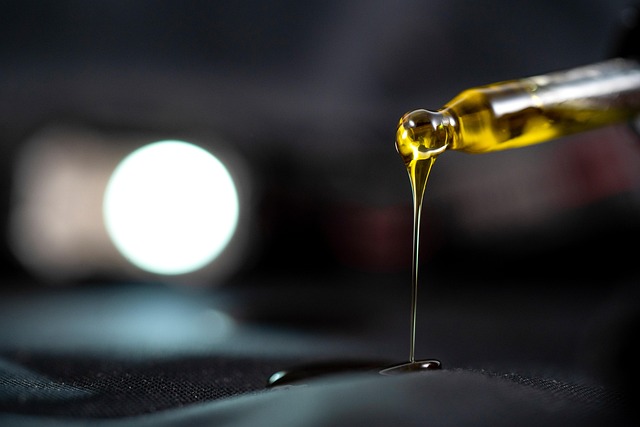TL;DR:
High-potency cannabinoids (HPCs) are cannabis products with elevated levels of THC and/or CBD, offering targeted relief for conditions like chronic pain, anxiety, and sleep issues. With growing popularity, advanced cultivation and extraction techniques enable precise dosing, enhancing the consumer experience. Accurate measurement methods, such as HPLC and GC-MS, ensure product quality and safety. While HPCs provide intense therapeutic effects, responsible use is crucial due to potential risks. Future research explores lesser-known cannabinoids and innovative delivery systems for enhanced efficacy and patient safety. Consulting healthcare professionals before using HPCs is essential, especially with pre-existing conditions or other medications.
“Unraveling the world of high potency cannabinoids, this comprehensive guide offers a deep dive into understanding and measuring these potent compounds. From the basic knowledge of cannabinoid potency to advanced measurement techniques, we explore why high-potency varieties matter in today’s cannabis market.
Learn about the benefits and risks associated with these powerful substances and gain insights into future research directions that could shape the industry. Discover the science behind high potency cannabinoids and their impact on consumer experiences.”
Understanding Cannabinoid Potency: The Basics

Cannabinoid potency refers to the strength or concentration of active compounds within a product, primarily tetrahydrocannabinol (THC) and cannabidiol (CBD). High potency cannabinoids are those with exceptionally high levels of these compounds. In the case of THC, products may be considered high potency if they contain 20% or more of this cannabinoid. CBD-rich products, on the other hand, often have a concentration of at least 15% CBD. Understanding these concentrations is crucial when navigating the market and ensuring you’re using products that meet your needs.
Knowing cannabinoid potency helps consumers make informed decisions about their use. High potency may offer more intense effects for those seeking relief from severe symptoms or enhanced relaxation. However, it’s important to remember that higher potency also comes with increased risk of side effects and may not be suitable for everyone. For instance, extremely high THC levels can lead to heightened anxiety or paranoia in some users. Therefore, consumers should always start with lower doses and gradually increase as needed to find the right balance.
High Potency Cannabinoids: What They Are and Why They Matter

High potency cannabinoids are a topic of growing interest in the cannabis industry, as consumers seek products with enhanced effects and targeted therapeutic benefits. These potent compounds are essentially concentrated forms of the natural chemicals found in the cannabis plant. The focus on high-potency cannabinoids is driven by their ability to deliver more intense experiences and provide specific relief for various conditions.
The significance lies in their potential to offer personalized and effective solutions, whether it’s managing chronic pain, alleviating anxiety, or aiding sleep. With advancements in cultivation techniques and extraction methods, cannabis producers can now create products with precisely measured dosages of these powerful compounds, ensuring a more tailored approach to consumer needs.
Measuring Cannabinoid Concentration: Techniques and Tools

Measuring cannabinoid concentration is a critical aspect of understanding and utilizing the potential benefits of these compounds, especially when it comes to high potency cannabinoids. Traditional methods involve laboratory analysis using techniques such as High-Performance Liquid Chromatography (HPLC) and Gas Chromatography-Mass Spectrometry (GC-MS). These sophisticated instruments separate and identify different cannabinoids present in a sample, providing precise quantification. The samples are typically prepared through extraction processes, where specific solvents are used to isolate the desired compounds from other components in the plant material.
Modern advancements have also introduced portable testing kits, offering quicker on-site analysis. These tools utilize colorimetry or immunoassay technologies to detect and measure cannabinoid levels, making them convenient for various industries, including healthcare, research, and agriculture. With the global cannabis market expanding, accurate measurement techniques are essential to ensure product quality, consistency, and safety, especially as consumers seek products with higher cannabinoid concentrations.
Benefits of High Potency Cannabis Products

Cannabis products with high potency levels offer a range of benefits due to their concentrated levels of cannabinoids, particularly THC and CBD. These compounds have been found to interact with the body’s endocannabinoid system, playing a significant role in regulating various physiological processes. High-potency options allow for precise dosing, ensuring individuals can tailor their intake to specific needs or preferences. This precision is especially beneficial for those seeking targeted relief from chronic conditions like pain, inflammation, or sleep disorders.
Moreover, the higher concentration of cannabinoids means that users may experience more intense therapeutic effects. This can lead to faster and more effective treatment outcomes. For instance, patients with severe anxiety or depression might find significant improvements in their symptoms after consuming high-potency cannabis products. However, it’s crucial to approach these products responsibly, considering their potency and the potential for heightened sensory experiences.
Potential Risks and Considerations

When considering high potency cannabinoids, it’s crucial to acknowledge potential risks and make informed decisions. While these compounds offer significant therapeutic benefits, their potency also means they can have more pronounced effects, which may not be suitable for everyone. Unregulated consumption could lead to adverse reactions, especially in individuals with pre-existing health conditions or those taking other medications.
One key consideration is the possibility of increased side effects, such as heightened anxiety, dizziness, or cognitive impairment. Additionally, the interaction between high potency cannabinoids and certain substances can be complex, potentially altering their efficacy or causing unexpected outcomes. Therefore, consulting with healthcare professionals before incorporating high-potency products into one’s wellness routine is essential for safe and responsible use.
The Future of High Potency Cannabinoid Research

The future of high potency cannabinoids research looks promising, driven by a growing acceptance and demand for cannabis-based therapies worldwide. As scientific understanding deepens, researchers are exploring the potential of these potent compounds to treat a wider range of conditions, from chronic pain and anxiety to neurological disorders. The focus is shifting from THC and CBD towards lesser-known cannabinoids like CBG, CBN, and CBC, each offering unique therapeutic benefits.
Advancements in cultivation techniques and extraction methods enable the production of high-purity, ultra-potent cannabinoids, expanding the scope of clinical trials. These developments hold the key to unlocking the full potential of cannabis medicine, providing relief for patients seeking alternative treatments. The ongoing research aims to optimize dosage forms, delivery systems, and combination therapies to enhance efficacy and patient safety.
